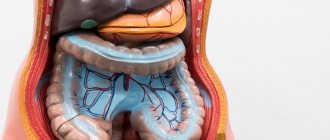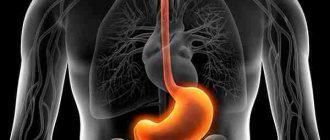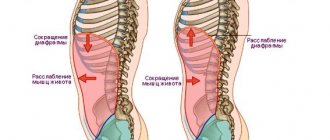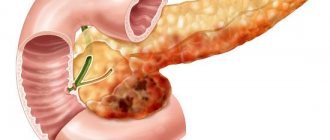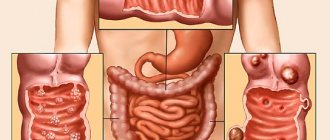How does the stomach work?
The stomach is an important organ in the human digestive system. He takes food and drinks, and the digestion process begins in him. How does this happen? Food enters through the mouth and esophagus into the stomach, where it accumulates and is subjected to mechanical and chemical processing. Gastric juice, which contains hydrochloric acid and digestive enzymes, breaks down food. Here water, sugar, salts begin to be absorbed and the Castle factor is produced, which is responsible for hematopoiesis (blood formation) and the absorption of vitamin B12. Hydrochloric acid plays two important roles - it breaks down food elements and has bactericidal activity, protecting the intestines from harmful microorganisms that may be contained in food. Pain in the stomach area indicates some problem in this important organ. But in addition to the symptom, the pain itself brings a lot of suffering, because it can be very strong or quite weak, but long-lasting.
Nature of pain
Most often, the cause of discomfort or serious illness in the stomach is a negligent attitude towards proper nutrition and an adjusted diet.
Based on the symptoms of pain, you can identify the cause of the disease:
- If after the last meal there are characteristic pains in the stomach for half an hour, the pain is uniform and aching. 3 hours after eating (as soon as the food is digested), the pain subsides. These symptoms are characteristic of partial damage to the stomach or the early stage of an ulcer.
- If you eat at least 5 times a day, pain is not observed. As soon as the interval between meals exceeds 4 - 5 hours, severe stomach pain occurs. After eating, the pain immediately stops. These symptoms indicate the presence of an ulcer or signal a pre-ulcerative condition.
- Pain that occurs regardless of food intake. In some situations, pain occurs after the digestion of food has finished. In this case, the pain is acute. These symptoms can be observed with gastritis of the stomach, gastroduodenitis, pancreatitis or stomach cancer.
How does your stomach hurt?
The stomach can hurt for many reasons, because violations of its functions, damage to the mucous membrane lining the wall of this organ, malfunctions of the sphincters are always associated with the appearance of pain. When you visit a doctor about pain in the stomach, you can always hear the main question: what is the nature of the pain and when does it appear? Pain in the stomach for a certain reason has its own definitions - nagging, sharp, “gnawing”, at night, after eating, before eating, constant. But according to the patient, it is difficult for the doctor to make a definite diagnosis, and therefore additional tests and examinations are prescribed to clarify the diagnosis. Only a well-made diagnosis will help the doctor prescribe adequate treatment. One of the common diseases is gastritis. It appears for many reasons, and most of us begin to suffer from it in school due to poor nutrition and constant stress. Stomach pain relievers for gastritis are the most popular over-the-counter drugs among pharmacy customers.
Abdominal pain in children
Although there are serious causes of abdominal pain, “mild” illnesses such as bloating, upset stomach or indigestion are more common. In children, it is almost impossible to know the nature of the pain, so you should very carefully monitor the general condition of the baby. If he eats with appetite, is active and mobile, then there is probably no cause for concern. In this situation, special suppositories with paracetamol or a decoction of dill water, which will improve peristalsis, can help relieve abdominal pain in a child. But if the baby has pale skin, has a fever and is capricious, then it’s worth calling the emergency room. When palpating the abdomen, in this case, worsening symptoms may be observed, and the abdomen itself will be hard and tense. Parents are especially concerned about young children who cannot express what hurts them. Symptoms of abdominal pain in infants usually include pulling the knees toward the chest and constant restlessness and crying.
Necessary examinations
In order to prescribe antispasmodics, drugs that reduce or increase the secretory activity of the gastrointestinal tract, the doctor must correctly establish the diagnosis. And for this, the patient, in addition to collecting a detailed history and verbal description of pain or problems with the gastrointestinal tract, is prescribed ultrasound examinations, esogastroduodenography, and, if necessary, computed tomography. These studies can identify neoplasms, destruction of the lining of the stomach or its pylorus, problems in the structure of tissues or the structure of internal organs that can cause pain. Only after a thorough examination will the doctor be able to prescribe treatment with the necessary drugs.
Medicines for pain relief
As mentioned above, pain can occur with various diseases and ailments of the stomach. Of course, only a gastroenterologist can prescribe the correct treatment.
The following medications are commonly used to relieve pain:
But - shpa. Helps relieve pain caused by spasm. This drug is used even for small children and pregnant women. Take one tablet three times a day after meals. It is recommended to drink No-shpa for five days. A repeated course is carried out only as prescribed by the underlying doctor.
Almagel. The drug is available in the form of a suspension. In addition to pain relief, this medicine has a beneficial effect on the gastric mucosa, relieves inflammation and relieves discomfort. Almagel is popular among people with gastrointestinal diseases due to its quick relief of discomfort. After a single dose, the effect is observed within five minutes. It is recommended to take one scoop twice a day before meals.
Maalox. The medicine is available in the form of tablets and suspension. Many doctors recommend using a suspension to relieve pain. Thanks to its enveloping properties, the effect occurs much earlier than from taking pills. Shake the suspension thoroughly before use. We take 15 ml of the medicine half an hour after the last meal. The maximum daily dose is 40 ml.
Neurotropic antispasmodics
Among the painkillers prescribed for stomach pain, antispasmodics are often used. These drugs are quite numerous, and among them neurotropic drugs are allocated to a special group. What is their action based on? On the influence on the functioning of the smooth muscle nervous system. These drugs interrupt the transmission of irritating impulses, which does not relieve the pain itself, but allows you not to feel it. Painkiller injections for stomach pain often contain a substance such as hyoscine butyl bromide. It actively suppresses m-cholinergic receptors of the gastrointestinal tract, which effectively relieves pain from stomach and duodenal ulcers, colic and cholelithiasis. Neurotropic antispasmodics are produced under proprietary names: Buscopan, Gastril, Metacin, Gastropin, Piregexal. These drugs are dispensed from pharmacies without a doctor's prescription, but require strict adherence to the recommended regimen and dosage of use.
Traditional methods
Not only medicinal painkillers for abdominal pain can help the patient. There are many folk remedies that effectively treat discomfort. What painkillers for abdominal pain can be made from natural ingredients? Rice water with fennel helps to improve peristalsis. The thick drink coats the intestinal walls and acts no worse than pharmaceutical drugs. Ginger decoction can solve the problem of constipation and impaired peristalsis. The root of the plant increases the production of digestive juices and acts as a mild pain reliever. For gastritis or stomach ulcers, potato juice with honey has a good effect. To prepare it, you need to grate the potatoes and strain the resulting mixture. For a more pleasant taste, you can add honey. The starch contained in potatoes coats the walls of the stomach and relieves discomfort. A decoction of chamomile leaves with plantain has a healing and anti-inflammatory effect. Therefore, it is drunk for ulcers and stomach erosion. Folk remedies for abdominal pain help well in mild cases. But if the pain does not go away for a long time and other unpleasant symptoms are added to it, you need to consult a doctor.
Muscle relaxants
Another large group of drugs that help get rid of stomach pain are myotropic antispasmodics. Otherwise, they are also called muscle relaxants. The effect of these drugs is due to their active biochemical activity, which can suppress reactions in cells that result in the sensation of pain. Such products include the well-known “No-shpa” and “Papaverine”. Undoubtedly, only the attending physician should prescribe an anesthetic for the stomach. In the vast majority of cases, taking muscle relaxants allows you to quickly relieve the spasm that causes pain. But we should not forget that such drugs mask some diseases, preventing the cause of pain from being quickly and accurately determined, so taking muscle relaxants should be recommended by a doctor based on the results of the examination.
General principles of therapy
Usually, if your stomach hurts, it is a symptomatic manifestation of a short-term and harmless disorder such as cramps and indigestion.
At the same time, despite fairly harmless causes, pain in some areas of the abdomen can cause serious discomfort to the patient.
There are a large number of methods to get rid of stomach pain, including basic exercises, home remedies and some dietary changes.
When none of the above methods help, this means that pain in the abdomen is caused by more fundamental factors, for example, appendicitis.
If a person experiences prolonged acute abdominal pain, they should urgently visit a medical facility.
With a correct diagnosis, specialists will be able to treat the pain by prescribing appropriate medication or recommend surgery.
Similar to prevention, treatment for abdominal pain will depend on the cause of the pain.
Antibiotics, proton pump inhibitors, acid blockers, antacids, and antispasmodics are among the types of medications that will be prescribed to relieve pain.
If any complication occurs in the kidneys, ectopic pregnancy, or cancer, the question may arise about the need to use surgical methods.
While abdominal pain can be the result of simple causes, it can also occur due to serious illnesses.
When symptoms are detected at the initial stage, it is possible to exclude complications and negative health consequences.
If a severe illness is diagnosed, it can be cured through timely therapy or surgery, and abdominal pain can be completely eliminated.
Pain medications that treat the underlying cause can be effective in reducing stomach pain.
However, these drugs should only be prescribed by a doctor. Moreover, the dosage may vary from one patient to another depending on the cause and condition of the patient.
If constipation is a causative factor in abdominal pain, mild laxatives can help stimulate bowel movements, reducing painful feelings of prolonged abdominal pain.
Enterosorbents
Poisoning with low-quality products is a common cause of disturbances in the gastrointestinal tract and pain in the stomach. Poisoning can also occur if toxic substances are taken through negligence or intentionally. In such cases, enterosorbents are recommended for use, allowing exogenous and endogenous substances to be removed from the body by binding them. For example, the well-known drug “Smecta” for stomach pain, or activated charcoal, is one of these medications. The only thing is that these drugs act rather slowly, but they are absolutely harmless.
Tablets for painful menstruation
Most women have experienced “menstrual syndrome” at least once in their lives. Due to the increased production of estrogen and progesterone, patients often complain of headaches, discomfort in the lower abdomen and general poor health. How to relieve pain in the lower abdomen? If you are experiencing severe pain before or during your period, then only a specialist can help after conducting a series of tests. Perhaps the problem lies in a hormonal imbalance or in another part of the body. If the pain is not a periodic phenomenon, then non-steroidal anti-inflammatory drugs can relieve it. The most popular among them are the following medications:
- "Ketoprofen".
- “Naproxen.”
- “Ibuprofen.”
It is important to remember that these drugs are not recommended for pain localized above or near the navel, and the course of use should also be limited to three days. If the pain does not go away within this time, you should consult a doctor. But there are patients who do not benefit from non-steroidal anti-inflammatory drugs. In this case, you can try other painkillers for pain in the lower abdomen - analgesics:
- “Ketonal.”
- “Analgin.”
- “Ketanov.”
In addition to analgesics and non-steroidal anti-inflammatory drugs, there are antispasmodics, which are also very effective as pain relievers for lower abdominal pain in women. These are such well-known drugs as “Spazmalgon”, “No-shpa”, “Papaverine”. These medications are not recommended for pregnant women, people with low blood pressure or kidney failure. How to take painkillers for abdominal pain during menstruation? To eliminate even strong unpleasant sensations, it is enough to take 4-6 tablets of “No-shpa” or one tablet of “Spazmalgon”. This will temporarily relieve the pain, but after a few hours it may reappear.
Enveloping drugs
When choosing an anesthetic for the stomach, you should clearly know the cause of this pain. If it is caused by irritation of the mucous membrane lining this organ from the inside, then enveloping drugs should be taken - non-absorbable antacids. For example, a suspension for stomach pain called “Almagel” has been in demand among such patients for several decades. Such drugs protect the mucous membrane from the irritating effects of gastric secretions, as well as ingested food. The composition of enveloping drugs for relieving stomach pain includes:
- aluminum salts of phosphoric acid;
- aluminum-magnesium-silicon or sodium-calcium combinations;
- alginates.
In addition to Almagel, such products include Gaviscon, Maalox, Relzer, Phosphalugel, Enterosgel and many other pharmaceutical products. They act for quite a long time - up to 3-4 hours.
Indications for taking painkillers
The patient can take painkillers under the following conditions:
- lack of tension in the muscles of the anterior abdominal wall (this is an indication for hospitalization, and not for self-medication);
- dull, aching or sharp pain in the upper abdomen (epigastric region);
- presence of similar episodes in the past;
- the presence of a connection between the occurrence of pain and food intake;
- confirmed diagnosis: gastritis;
- peptic ulcer;
- gastroesophageal reflux disease (GERD);
- functional gastric dyspepsia.
Antacids
Pain in the stomach area can be caused by many reasons, which should be determined by a doctor after a thorough examination. Perhaps they are due to the increased production of gastric secretions, which contain a large percentage of hydrochloric acid. To rid the stomach of its negative effects, soluble antacid drugs are used, they are also called absorbable. These are substances such as:
- sodium bicarbonate (baking soda);
- magnesium oxide (burnt magnesia);
- calcium carbonate;
- magnesium carbonate.
Medicines based on these active substances work quickly, relieving pain, but have many negative side effects. One of them is acid rebound. This effect occurs against the background of a sharp decrease in the level of acidity in the stomach, due to which the stomach begins to produce hydrochloric acid even more actively, resulting in heartburn. Such drugs are not recommended to be taken in the evening after meals, since at night it will be impossible to compensate for the release of hydrochloric acid by eating. Among the pharmaceutical drugs belonging to this group is the widely advertised “Rennie”.
Types of painkillers used for gastritis
To relieve pain, medications from different pharmacological groups are used:
- Antispasmodics. They slow down cellular activity that causes muscle contractions and affect the cytoplasm of the cell.
- Anticholinergics. They act on the receptors of nerve endings, effectively neutralizing pain attacks.
- Antacids. They have a therapeutic effect by enveloping the inflamed mucous membrane of the stomach, reducing the destructive effect of hydrochloric acid - the cause of pain.
- Traditional medicine preparations. Gently but effectively, with prolonged use, they help relieve pain in the epigastric area.
When using all medications, you must carefully observe the dosage, duration of use, and take into account contraindications.
Proton pump blockers
Stomach pain is most often associated with increased levels of acid in digestive secretions. And if this is actually the case, then tablets for stomach pain should have antisecretory activity and reduce the production of this component of the working substance of the stomach. Pharmacology is trying to develop new drugs that help fight various diseases. So, to eliminate stomach pain, a group of drugs called “proton pump inhibitors” has been developed. The action of the active components is based on blocking the production of hydrochloric acid by special cells of the stomach with the help of special cellular substances - a proton pump. Today, these medicinal components are used in the treatment of a significant list of diseases of the gastrointestinal tract. Painkillers for stomach pain, called proton pump inhibitors (blockers), are capsule dosage forms. These include pharmaceutical products "Dexlansoprazole", "Lansoprazole", "Omeprazole", "Pantoprazole", "Rabeprazole", "Esomeprazole".
Suspensions
The mechanism of action of the drug Gaviscon.
- "Almagel". Effective antacids, which are released in the form of a suspension. Ingredients include magnesium and D-sorbitol. The medication looks like a viscous liquid. "Almagel" has an enveloping effect. The drug is prescribed for the treatment of symptoms of hyperacid pathological conditions, stomach and duodenal ulcers, esophagitis. “Almagel” eliminates pain, causes bile secretion, and promotes relaxation. Anesthesin, which is one of the components of the mixture, anesthetizes, which makes it possible to prescribe medication when pain occurs in the abdominal cavity. For the treatment of hyperacid pathological conditions, the drug must be taken according to Art. spoon. The same dose is required for the treatment course. "Almagel" should be consumed daily, 2-3 rubles. Side effects include constipation, weakness and fatigue (in case of overdose). The drug should not be prescribed if the patient has impaired renal function.
- "Enterosgel". Due to its medicinal properties, the medication absorbs substances harmful to the body, removing them. At the same time, Enterosgel does not affect enzymes and has a beneficial effect on the functioning of the gastrointestinal tract, restoring beneficial microflora. The medication can be used for diarrhea, intoxication, psoriasis, dermatitis, and against rashes. Enterosgel promotes detoxification and is well adsorbed in the intestinal contents and blood. The product allows you to remove toxic and other harmful substances, pathogenic bacteria. Eliminates toxicosis, helps improve the functions of the gastrointestinal tract of the liver, kidneys, and helps normalize blood test values. In addition, Enterosgel envelops the mucous membrane of the abdominal cavity and intestines, thereby protecting organs from pathogens, preventing the appearance of erosions and ulcers. The drug is not absorbed from the gastrointestinal tract. The detoxifier increases the body's protective functions.
- "Maalox." The variety in which Maalox drugs are produced allows a specialist to choose the dosage form necessary for the treatment of various pathological processes. "Maalox" can be selected for each individual case. The suspension is the most successful combination of the fast-acting substance “Maalox” and the release form. When consumed, Maalox envelops the esophagus, abdominal cavity and duodenum with a film. "Maalox" helps neutralize acid and suppresses secretion. “Maalox” removes toxins and harmful substances from the patient’s body that negatively affect the gastrointestinal mucosa. Thus, “Maalox” helps to increase the patient’s immunity.
- "Phosphalugel". Phosphalugel contains agar-agar and other substances. The product is produced in plastic bags. Doctors prescribe 1-2 sachets for each appointment. The drug must be taken with water or diluted in half a glass of liquid. Contraindications and side effects are the same as for Almagel. The medication has an adsorbing effect, neutralizes acid, and absorbs harmful microorganisms. In addition to the above properties, this medication removes toxins, eliminates gases and harmful bacteria in the gastrointestinal tract. The drug "Phosphalugel" helps prevent alkalization of gastric secretions, while maintaining the required degree of acidity. "Phosphalugel" forms a protective film on the membranes of the gastrointestinal tract.
- Gaviscon. The drug is used to treat symptoms caused by increased levels of acid in the stomach, heartburn, and a feeling of heaviness. The medication can be used during breastfeeding and pregnancy. Children over the age of twelve and adults can take 10-20 milliliters of medication after meals or in case of pain or other symptoms. The permissible dosage of the drug is 80 milliliters per day. Children from 6 to 12 years old are prescribed 5-10 milliliters of suspension after meals and before bedtime, the maximum dosage is 40 milliliters per day.
Antimicrobial agents
Scientific research has established that very often the cause of gastritis, and therefore stomach pain, is a bacterium (Helicobacter pylori). By destroying this uninvited inhabitant of the gastrointestinal tract, you can forget about the problems caused by its vital activity. An anesthetic for the stomach, which helps specifically with such problems, contains bismuth derivatives that fight the bacterium itself and also have protective functions for the gastric mucosa. Bismuth penetrates deeply into the layers of mucosa lining this important organ of the gastrointestinal tract, which leaves the bacteria no chance to multiply again and begin its destructive work for humans. But it is known that Helicobacter pylori quite often causes ulcers. Tablets for stomach pain based on bismuth derivatives are an effective means of combating stomach bacteria. These products include: “De-Nol”, “Biskol”, “Ventrisol”, “Duosol”, “Tribimol”, “Ulceron”.
Painkillers
Before taking medications that relieve pain, you need to understand which groups they belong to. At the moment, there are several types of painkillers in the world for abdominal pain.
- Enterosorbents effectively help relieve pain from food poisoning. They “recycle” toxic substances, bringing immediate relief. But since enterosorbents are not painkillers in the truest sense of the word, they may not be effective for other diseases.
- Antispasmodics are painkillers for pain in the lower abdomen. During menstruation or diseases of the genitourinary system, they can help relieve unpleasant symptoms. Antispasmodics significantly relieve pain in internal organs by relaxing smooth muscles.
- Non-narcotic analgesics are the most common for pain relief. They do not eliminate the cause of the pain, they simply mask it and also have a strong effect on the liver. Therefore, their use for more than one to three days is strictly not recommended.
- Opiates are used primarily in hospital settings to treat moderate to severe pain. Opiates and narcotic painkillers are often used in cancer patients.
- Non-absorbable antacids help eliminate abdominal pain without affecting other body processes and have an immediate effect. Antacids reduce acidity in the stomach, which has a positive effect on the health of patients suffering from ulcers or gastritis.
Plants that help with stomach pain
Many medicinal plants have been used in folk medicine since ancient times as pain relievers for the stomach. And now some of the recipes of our great-grandmothers serve as an effective additional aid in the treatment of diseases of the gastrointestinal tract. For example, flax seed or oats. These plant components have an enveloping effect, protecting the walls of the stomach from the aggressive effects of secretions or food. Boil flax seed or oats and drink before meals - protection and assistance to medicines are provided. You can use this collection to cope with spastic pain:
- Valerian, rhizome with roots - 1 measure.
- Watch (trifol), sheet - 1 measure.
- Peppermint, leaf - 1 measure.
- Hop cones - 1 measure.
Mix all components. Then pour 1 tablespoon of the mixture into half a liter of boiling water and keep in a steam bath for half an hour. Let the infusion cool, strain it through a strainer. Take half an hour before meals or an hour and a half after meals, dividing the resulting amount into 5-6 doses per day.
Instructions for use of the medication
Doses and duration of treatment are determined individually depending on the diagnosis, severity of symptoms and age of the patient. The contents of the sachet are brought into a homogeneous state with your fingers and taken orally. If desired, dissolve the gel in 100 ml of boiled water.
Treatment of gastritis and ulcers
In the treatment of inflammatory diseases associated with the formation of the pathogenic bacterium Helicobacter pylori on the walls of the gastrointestinal tract, Phosphalugel is prescribed as an adjuvant. Its task is to neutralize excess hydrochloric acid and protect sensitive mucous membranes from its effects.
For gastritis, esophagitis or ulcers, you need to take Phosphalugel 2-3 times a day, one sachet. It's better to do this before meals. The duration depends on the severity of the disease.
The minimum course is 7 days.
Treatment of gastritis or peptic ulcer begins strictly after diagnosis - FGS.
If an examination of the mucous membrane from the inside reveals a pathology, then for its successful treatment, a whole range of other drugs are taken along with an antacid:
- antibiotics to destroy pathogenic bacteria;
- probiotics to restore optimal microflora;
- histamine receptor blockers to normalize the production of hydrochloric acid;
- sorbents for removing toxins;
- gastroprotectors to protect and restore the mucous membrane.
If the treatment of gastritis and ulcers is not approached comprehensively, but only to dull the pain with analgesics, the symptoms will return every time after stopping the drugs. It is important to influence the cause of the disease. While pathogenic bacteria multiply on the walls of the mucous membranes, the patient will be bothered by heartburn, bloating and pain.
Phosphalugel for viral infections
Antacids are useful not only for gastritis and other inflammatory diseases of the gastrointestinal tract. Therapists prescribe similar drugs to relieve bloating and diarrhea due to rotavirus infection. The medicine will help with nausea, weakness and vomiting. It is taken according to a scheme similar to other diseases. The gel is drunk 2-3 times a day for 3-4 days.
You can stop treatment earlier if there are no symptoms of digestive upset.
The therapy will be effective if the patient simultaneously takes antiviral drugs - Kagocel, Ingavirin, Viferon. To relieve fever, which often develops against the background of rotavirus infection, Paracetamol or Citramon is recommended.
In addition, you will need to stay in bed, take vitamins to strengthen your immune system, and drink more fluids.
Phosphalugel for poisoning
Food poisoning is another indication for the use of antacid medications. Phosphalugel will help you quickly get rid of vomiting, diarrhea, and bloating. It is important to start taking it as soon as possible, at the first signs of poisoning.
The dose for an adult patient is one sachet. On the first day of poisoning, in case of severe nausea and diarrhea, the drug is taken orally every 3-4 hours. Then the dosage is reduced to 2-3 sachets per day. Drink the medicine for 5-7 days.
Additionally, you will need to take sorbents. Smecta, Entrosgelb, Polysorb have proven themselves well. These medications absorb toxic particles in the intestines and bring them out in a bound, neutralized form. In case of poisoning, you will need to adjust your diet. In the acute phase, the patient usually has no appetite. It is better to drink plenty of fluids so as not to upset your electrolyte balance. After the main symptoms are relieved, cereals and fermented milk products are introduced into the diet.
Use in childhood
The drug has no age restrictions, so it can be safely used to treat pain and bloating in a child. Infants and infants are recommended to pre-mix the gel in water, milk or formula. Give ¼ sachet at a time.
Children from 2 to 6 years old with intestinal infections, poisoning, inflammation of the gastrointestinal tract are given ½ sachet 2-3 times a day. Both oral use of the gel directly from the sachet and dilution of the drug in liquid are allowed.
The minimum course lasts 5 days. Usually, the unpleasant symptoms of dyspeptic disorders in children disappear within 2-3 days. If Phosphalugel does not give the declared effect, it should be replaced with an age-appropriate analogue. Many manufacturers offer baby suspensions with a pleasant taste.
Reviews about the drugs
There are quite a lot of diseases of the gastrointestinal tract, manifested by pain in the stomach. Before taking medicine, it is necessary to find out the cause of the ailment. When visiting a specialized medical institution, you should undergo examinations and tests so that the doctor can make a diagnosis and prescribe adequate treatment. Medicines used as pain relievers for the stomach have different directions of action. Some of them are widely advertised on television and in print media, while others are praised by word of mouth. For example, the drug “Smecta” is recommended by absolutely everyone who has used it in the treatment of stomach pain, because, judging by the reviews, it helps relieve pain and alleviate the condition of both adults and small children. The drug “De-Nol” is also often recommended, which fights a common cause of gastritis and ulcers - the bacterium Helicobacter pylori. For several generations of patients suffering from stomach problems, they have been using the drugs Almagel, Gaviscon or Maalox. These enveloping agents help relieve pain in the stomach, protecting its mucous membrane from the aggression of food and gastric secretions. But in any case, you should not use medicines from the “neighbor”, because even relatives can suffer from a completely different gastrointestinal disease than the one that needs to be treated. So pain is a doctor's problem, not self-medication.
Cause of pain in gastritis
Gastritis pain is spasmodic in nature
The pain that occurs with this disease most often begins due to spasms of the smooth muscles of the stomach walls. Another reason may be excessive stretching of its walls. The mucous membrane of the stomach with gastritis is always inflamed, any mechanical impact on it (when food comes in) causes pain.
With gastritis with high acidity, excess acid irritates the gastric mucosa, a prolonged reflex contraction of the pylorus occurs, this spasm causes pain. The secretion of acid increases when food enters the stomach, and the nerve receptors of the mucous membrane suffer from this effect.
Only a gastroenterologist or therapist can assess the condition of a patient with gastritis and prescribe adequate treatment.
He will conduct a gastroscopy, prescribe laboratory tests, and advise painkillers for gastritis. Self-medicating without knowing the etiology of the disease is very dangerous. Information about medications used to relieve pain symptoms of gastritis is offered for informational purposes only.
What painkillers are used for injections?
Despite the fact that these are symptomatic drugs, their use is necessary for the treatment of many pathologies. If the patient experiences discomfort, his recovery will slow down. With chronic pain syndrome, performance decreases and depression develops. Therefore, painkillers are used in the following cases:
- after injuries, surgical interventions;
- during dental treatment, tooth extraction;
- severe migraine;
- renal, biliary or hepatic colic;
- arthritis, bursitis, arthrosis and other joint pathologies;
- osteochondrosis, spondylosis, intervertebral hernia;
- oncological diseases;
- painful periods.
Painkillers in tablets are usually used on their own. But if the pain is severe and oral medications do not help, injections should be used.
Medicines from several groups are used for this: analgesics, non-steroidal anti-inflammatory drugs, corticosteroids, local anesthetics, antispasmodics.
The list of such drugs is large, it is difficult to figure out which one is better on your own. But there are several remedies that are used most often. According to doctors and reviews from patients, these are the best painkillers.
| LS group | Active substance | Drug names | Indications for use | How long does it last? |
| Narcotic analgesics | morphine | Morphine, Diamorphine, Skenan, Omnopon | operations, fractures, malignant tumors, heart attack, | effect in 10 minutes, lasts 8-12 hours |
| Narcotic analgesics | codeine | Codeine, Codelmixt, Sedal-M, Caffetin, Solpadeine | operations, neuralgic, muscle and joint pain, dysmenorrhea, migraine | effective in 10-20 minutes, for 4 hours |
| Narcotic analgesics | trimeperidrine | Promedol, Naloxone | operations, heart attack, pericarditis, renal colic, neuritis, peptic ulcer, oncology, radiculitis, | in 10-20 minutes, 3-4 hours |
| Non-narcotic analgesics | metamizole sodium | Analgin, Baralgin, Optalgin, Spazmalgon, Tempalgin, Bral | neuralgia, operations, biliary colic, radiculitis | in 30 minutes, 3-4 hours |
| Non-narcotic analgesics | tramadol | Tramadol, Tramal, | trauma, neuralgia, oncology | in 15 minutes, 6 hours |
| Non-narcotic analgesics | butorphanol | Butorphanol, Moradol, Stadol, Naloxone | pain relief during childbirth, surgery, oncology | immediately, lasts 3-4 hours |
| NSAIDs | ketorolac | Ketanov, Ketorol, Dolak | injuries, radiculitis, neuralgia | 30 minutes, 6 hours |
| NSAIDs | dexketoprofen | Dexalgin, Dexonal, Ketodexal | operations, renal colic, arthritis, osteochondrosis | 20 minutes, 2-3 hours |
| NSAIDs | diclofenac | Diclofenac, Voltaren, Ortofen | arthritis, radiculitis, trauma, migraine, algodismenorrhea | 20 minutes, 2-3 hours |
| NSAIDs | ketoprofen | Ketoprofen, Ketonal | arthritis, sciatica, sciatica, trauma, surgery | 15 minutes, 6 hours |
| Steroid hormones | hydrocortisone | Hydrocortisone | pain in joints and spine | after 6-20 hours, several days |
| Steroid hormones | dexamethasone | Dexamethasone, Dexasone | oncology, trauma, joint pathologies | 6 hours, several weeks |
| antispasmodics | drotaverine | Drotaverine, No-Shpa | colic, spasms, peptic ulcer, algomenorrhea | 3-5 minutes, 6-8 hours |
| antispasmodics | papaverine | Papaverine, | intestinal spasms, renal colic, angina pectoris, cholecystitis | 15-30 minutes, 4 hours |
To choose the right medicine, you need to take into account the patient’s age, the intensity of the pain and its cause. The strongest narcotic analgesics, Butorphanol, Ketanov, should not be used for ordinary headaches or toothaches. Joint pathologies and radiculitis are treated with non-steroidal anti-inflammatory drugs. And for spasms and colic, antispasmodics are needed.
Painkillers glucocorticoids
In medical practice, artificially created analogues of adrenal steroids are actively used. Such drugs relieve inflammation well, have an anti-shock and antihistamine effect. Intra-articular injections are used to eliminate severe pain. The injection is desired in the knee, shoulder, elbow or hip joint.
- Steroid hormones can only be prescribed in severe cases, as they destroy cartilage tissue.
- It is not allowed to give more than one injection every 2-3 months.
Contraindications:
- – arthritis of an infectious nature;
- – osteoporosis;
- – joint instability.
The best drugs for men over 50 for potency
What are the best pain-relieving injections among glucocorticoids?
"Hydrocortisone acetate"
Hormonal drug of synthetic origin. Most often prescribed for local anesthesia of the spine and joints. The medicine is effective for the following diseases:
- – bursitis;
- – arthritis;
- – rheumatism.
The maximum effect is achieved after 6 hours. The drug can damage cartilage tissue, so you can inject it no more than 5 times in 2 weeks.
"Dexamethasone"
The strongest representative of glucocorticosteroids. It has a strong analgesic and antihistamine effect, relieves inflammation. There is a rapid achievement of a positive result, which lasts for two or more weeks.
The drug is well tolerated and has rare adverse reactions. Prescribed to patients with rheumatoid arthritis and in the post-traumatic period. One injection is enough to achieve results. The injection can be repeated no earlier than after 30 days.
Necrosis may occur at the injection site. You can reduce the risk of developing complications. To do this, you need to avoid putting stress on the sore joint. During treatment it is strictly forbidden to drink alcohol.

